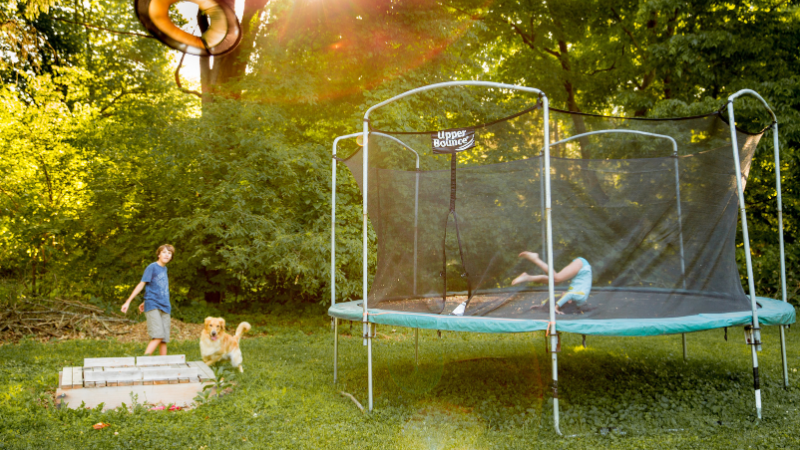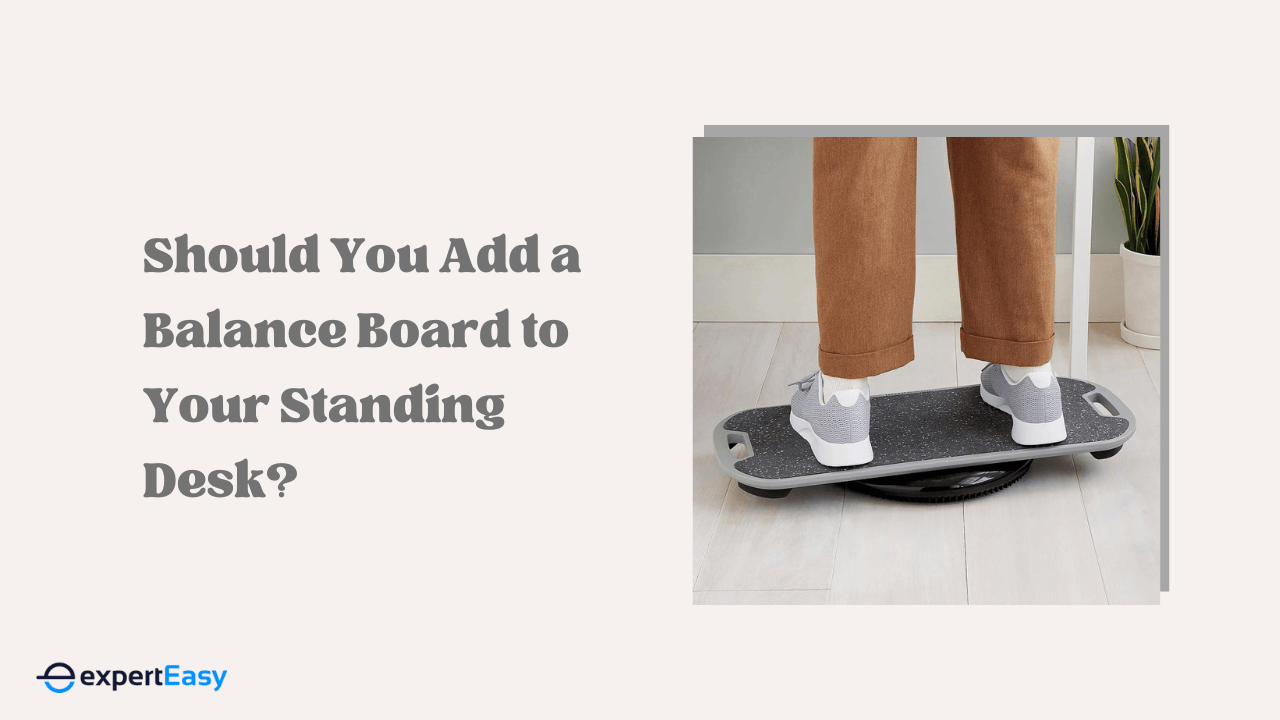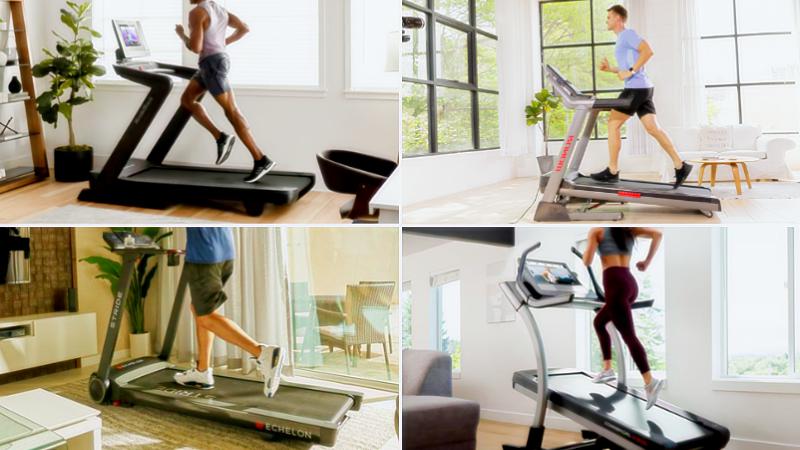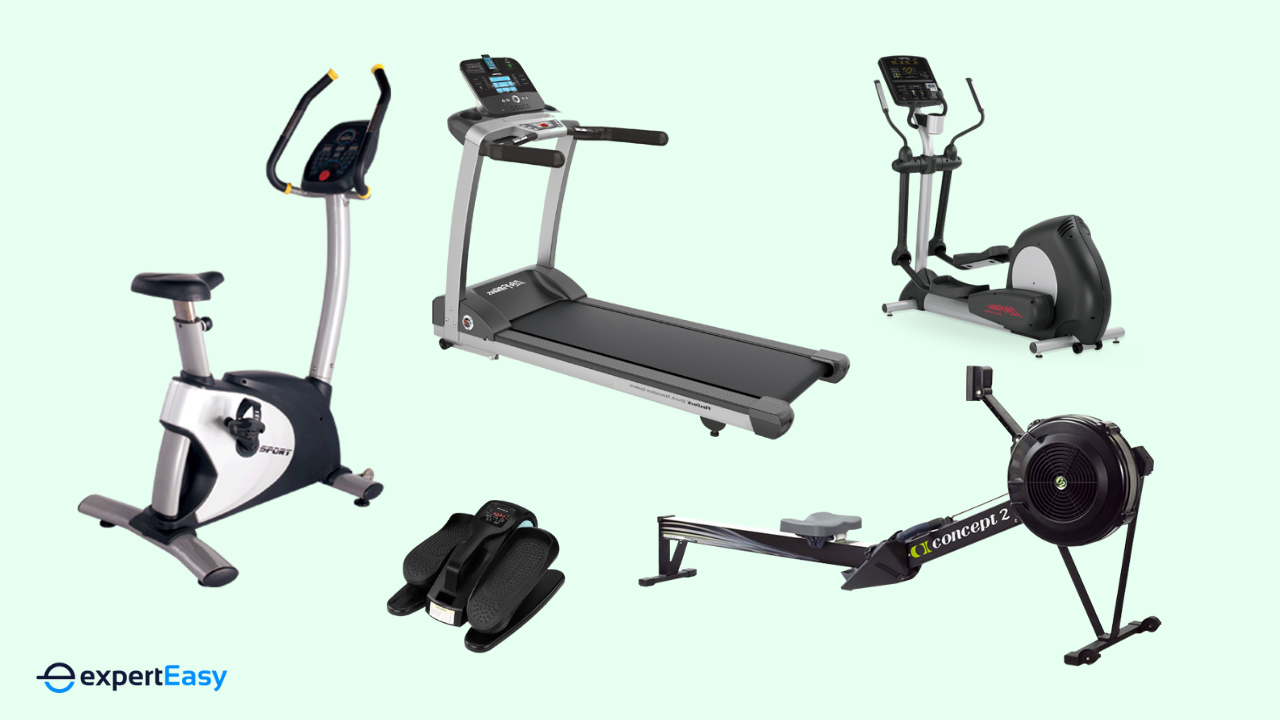Trampolines are a fun way to exercise, especially for kids. However, choosing the right one requires a fair understanding of the available sizes, weight limits, safety features, and intended use.
To make your work easier, we reviewed many options and shortlisted the best trampolines available to Australians based on expert insights and advice. The roundup is updated regularly, so you always have the best options to choose from. Let's start with our top picks.
Our Top Picks
We have seven trampolines in this roundup. But if you must make a quick purchase, here are our top three picks:
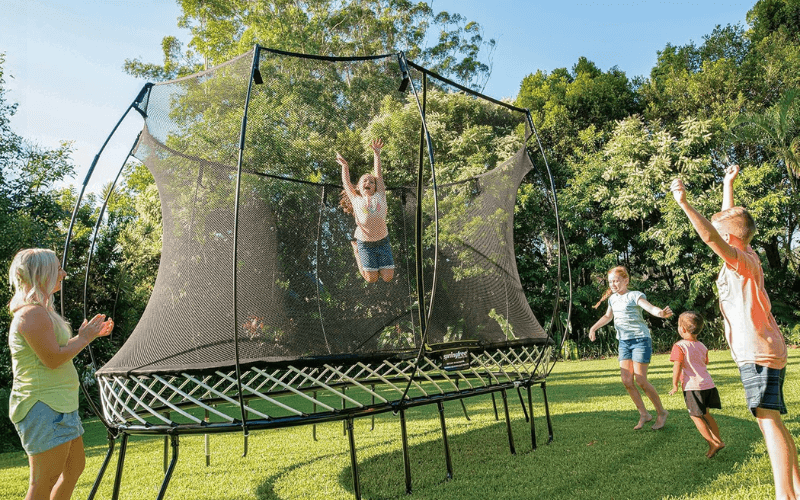
Springfree Oval Trampoline
Best all-round trampoline with Leaf Spring technology, Terylene enclosure material, and a maximum user weight capacity of 150 kg.
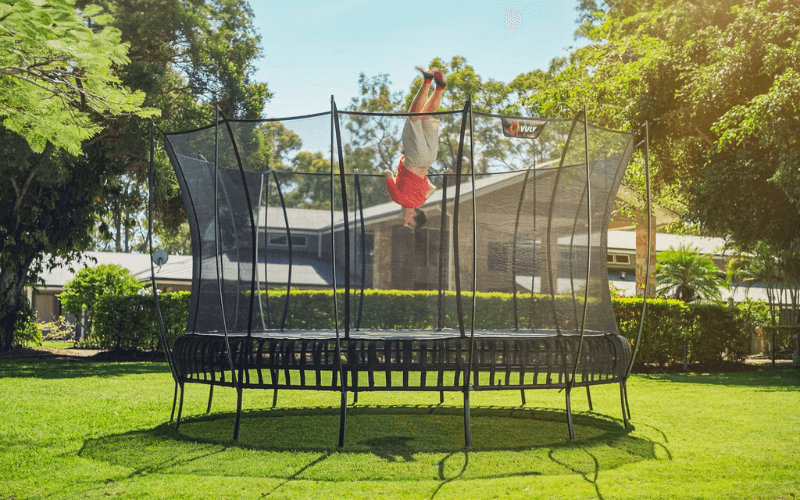
VULY Thunder 2 Pro
Best mid-range trampoline with three mat sizes up 375 cm diameter, 150 kg weight capacity, and a 10-year warranty on the frame tube and joiners.
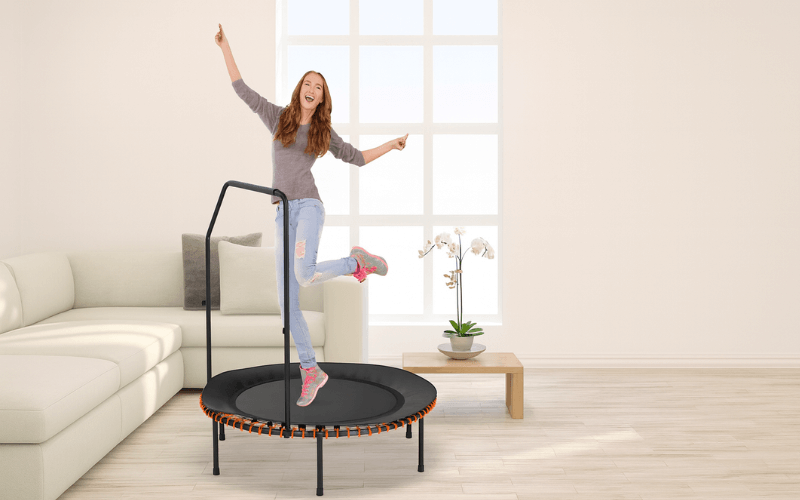
ADVWIN 48" Rebounder
Best rebounder in Australia with a 48" (122cm) diameter and a maximum weight capacity of 200 kg for low-impact workouts.
Top 7 Trampolines for Australians
Regardless of what you need a trampoline for, i.e., energetic play, fitness, or stargazing with your loved ones, we've handpicked and categorised each product review and analysis to help you find the right one.
1. Springfree Oval Trampoline
Best All-Round Trampoline

Size of mat: 2.4 x 4.0 m / 8ft x 13ft
Weight capacity: 700 kg
Warranty: 10 years
The Springfree Oval Trampoline's strongest selling point is its safety, which is why we consider it the best all-rounder. Instead of springs, it uses flexible rods tucked under the jumping surface, so that your toes don't get pinched. The net is also quite flexible, so when you bounce into it, you’re naturally guided back without hitting the rigid poles. If you're a parent, this peace of mind is huge if you anticipate your children using the trampoline daily.
The oval shape of Springfree's trampoline makes it a smart fit for long or narrow yards. It measures 8 ft by 13 ft, providing ≈ 92 square feet of jumping room. That’s enough for two to three kids to play together. Plus, at 2.7 m tall, the trampoline is spacious, and its 700 kg weight limit allows you to join in with your kids or even use it alone without straining the frame.
Springfree's biggest downsides are the price and assembly. At $2,299, it’s quite an investment, and our testing confirmed the user reviews: assembling the trampoline isn’t easy. We recommend paying for professional installation or using Springfree's BILT app for a seamless setup. Once it’s up, however, it proves worth it. Its safety, space, durability, and 10-year warranty make it one of the best trampolines if you’re serious about long-term backyard fun.
Pros
- More jumping space
- Shock-absorbent softedge mat
- Safe flexiNet enclosure
- Hidden rust-protected frame
- Built for safety
Cons
- High price
- Space requirements
- Installation cost
2. VULY Thunder 2 Pro
Best Mid-Range Trampoline

Weight capacity: 150 kg
Leaf spring count: 42
The Vuly Thunder 2 Pro sits in the same premium bracket as the Springfree Large Oval, and you can see why. Like Springfree, it ditches traditional springs and uses custom leaf springs for a smooth, vertical bounce with minimal injury risk.
It has three size options (M, L, XL), as shown in the table below, and is priced at $1,699, a middle ground between Jumpflex and Springfree.
| M | L | XL | |
|---|---|---|---|
| Weight Rating | 150 kg | 150 kg | 140 kg |
| Overall Diameter | 355 cm | 415 cm | 475 cm |
| Safety Net Height | 191 cm | 191 cm | 191 cm |
| Mat Diameter | 255 cm | 315 cm | 375 cm |
| Mat Height | 91 cm | 91 cm | 91 cm |
| Total Height | 288 cm | 288 cm | 288 cm |
Safety is where Vuly pushes hardest. There are no exposed springs, no pads needed, and the edge design removes hard contact points. Its enclosures use flexible poles and a door that overlaps, rather than a zipper, to reduce weak spots. In that sense, it’s closer to Springfree’s approach than Jumpflex, because it prioritises eliminating traditional trampoline hazards.
The trampoline's frame, backed by a 10-year warranty, is double galvanised and heat-treated to withstand Australia’s weather. The mat is also covered by a 5-year warranty, while the safety net and leaf springs are backed by a 1-year warranty. Compared to Springfree’s full 10-year coverage on every part, Vuly is strong but not quite as generous across the board.
For pure safety innovation, though, Vuly is right up there with Springfree, and better value if you don’t need the largest footprint.
Pros
- Safer and enjoyable bounce
- Durable and rust-resistant
- Endurance tested
- Meets safety standards
- Suitable for various sizes
Cons
- Weight limit considerations
- Visual impact in the backyard
3. JumpFlex Hero 14ft Trampoline
Best Value Trampoline
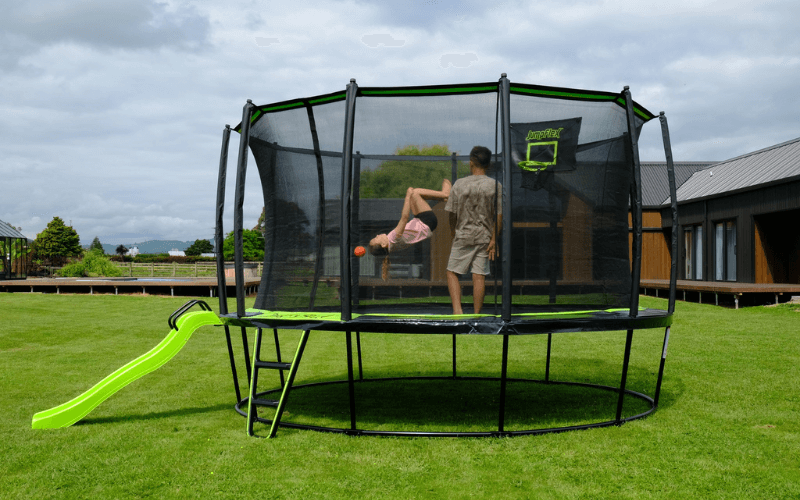
Weight capacity: 250 kg
Warranty: 10 years
The HERO 14ft trampoline is for families who want a reliable trampoline without paying the premium price of a Springfree. At $1,299, it’s almost half the cost of the Springfree Large Oval, but still gives you a 3.7m mat and a weight rating of 250 kg. Compared to Springfree's smaller models, such as the Mini Round or Compact Oval, JumpFlex Hero suits larger yards and groups.
One of the significant strengths of the HERO is its frame design. Jumpflex uses a dual-ring system with no bolts or welds, resulting in a stronger and more easily assembled structure. In fact, you can assemble it in under an hour, while the Springfree takes much longer and often requires professional installation. Its curved poles and 360° net enclosure keep jumpers safe, giving you peace of mind if younger kids are bouncing with older ones.
Where the HERO differs from the Springfree is the bounce system. Instead of hidden rods, it uses 88 high-tensile springs. So, if you prefer a deep, smooth bounce, this is a plus. The downside is that springs require a bit more care in the long run, and safety padding is essential. However, Jumpflex backs it up with strong materials and a 10-year warranty on the frame.
Pros
- Large 3.7 m mat
- Dual-ring steel frame
- 250 kg weight rating
- 10-year frame warranty
- Safety design
Cons
- Needs a wide yard
- Uses springs (less “injury-free”)
- Limited individual weight
4. Capital In-Ground Trampoline
Best In-Ground Trampoline
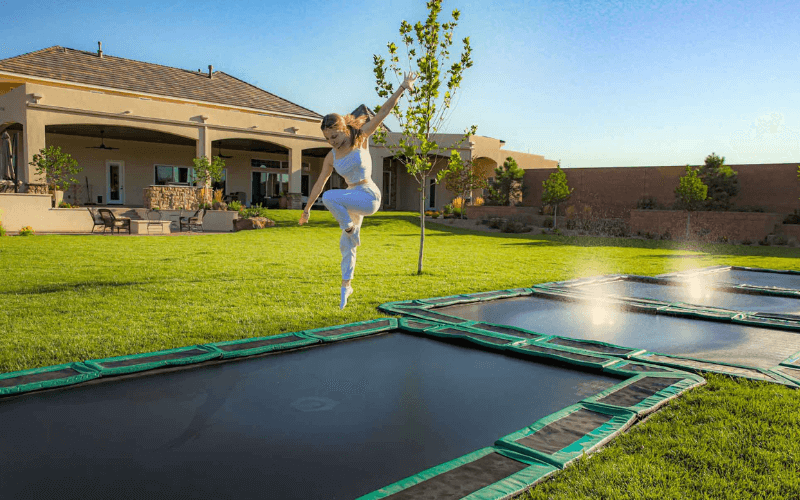
Weight capacity: 200 kg
Warranty: 10 years
The Capital In-Ground Trampoline features a double-strength frame constructed from 2 mm thick double-dip galvanised steel, backed by a 10-year warranty for long-lasting durability and reliability. The frame includes an integrated retaining wall made from recycled polypropylene.
The rectangular in-ground trampoline features vented safety pads that allow proper airflow while sealing the edges, and it also includes extra mesh over the springs. These provide additional protection and prevent fingers and toes from getting caught. Its 220 mm springs are made in Germany, and hot-dip galvanised to prevent rust. They are also conically shaped to give extra strength.
With a 200kg weight capacity, the trampoline is suitable for families and offers years of fun and safe bouncing. It includes a 10-year warranty on the frame and retaining wall, a 5-year warranty for the springs and jump mat, and a 2-year warranty for the safety pads and enclosure. Given its quality and performance, the in-ground trampoline is a great addition to any backyard.
Pros
- Safety-focused design
- Built-in retaining wall for easier installation
- Double-strength frame for durability
- 10 years frame warranty
Cons
- Requires careful sizing
- Uses traditional coiled springs
5. Plum 12ft Deluxe Round Trampoline
Best Trampoline for Kids
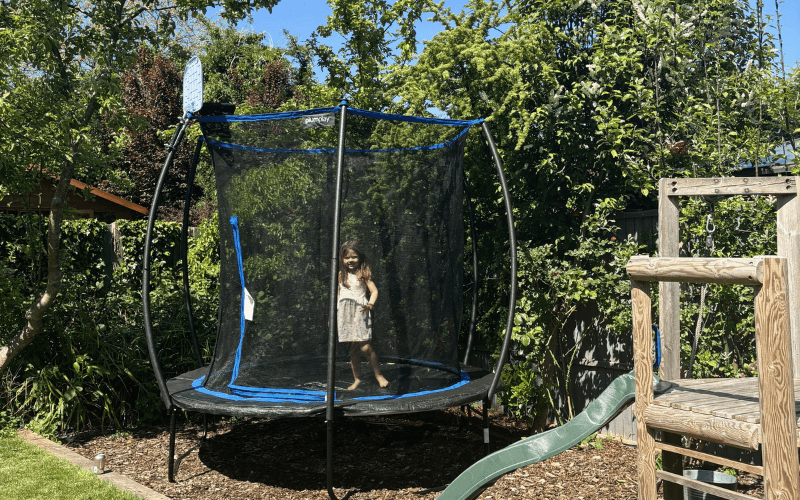
Weight capacity: ≈ 150 kg
Warranty: 12 months
The Plum Deluxe Round Trampoline is aimed at families with younger children, and it delivers on that promise. It uses Plum’s Springsafe enclosure, which keeps children completely separate from the springs and frame. This makes it safer than a basic budget trampoline, but not as advanced as the springless systems found in the Vuly Thunder 2 Pro or Springfree.
The trampoline's bounce quality comes from its zinc-coated springs and deluxe circular mat. It’s smooth and responsive, though you shouldn’t expect the same deep, powerful bounce that you’d get from the Jumpflex HERO or the German-spring setup on the Capital In-Ground. Instead, it's tuned more for fun than for tricks, which is why we recommend it for children who want everyday jumping fun rather than older teens practising flips or cheer moves.
Plum's frame is powder-coated and galvanised, with weather-resistant pads and net foam to withstand year-round use. However, the maximum weight capacity is just 80–150 kg, depending on the size you choose, which is much lower than Jumpflex’s 250 kg or Springfree’s 700 kg. This makes it less suitable for parents who want to join in alongside their kids.
Pros
- Springsafe enclosure
- Smooth, responsive bounce
- Weatherproof pads
- Accessory system
Cons
- Lower weight capacity
- Less advanced safety
- 12 months warranty
6. ADVWIN 48" Rebounder
Best Rebounder in Australia

Height: 88 - 104 cm
Weight capacity: 200 kg
The ADVWIN 48" rebounder is very different from the big outdoor trampolines we’ve looked at, but it fills its role well. It’s a budget-friendly way to get started with rebounding, whether for fitness, rehabilitation, or kids’ indoor fun. The rebounder has a maximum load of 200 kg, which is sturdy enough for daily workouts, and the foam handle provides extra balance support.
Assembly is generally easy, although some buyers note that it’s tough to unfold the frame at first; we didn't experience this problem during testing. However, once set up, it’s quiet and stable, with anti-slip feet that make it safe to use indoors. More importantly, the bounce is firmer than that of a full-size trampoline, but that’s expected given its smaller mat size.
Where it lags behind the bigger brands is in durability and warranty. You only get 1 year of coverage here, versus 10 years on Jumpflex and Springfree frames. It’s also not designed for tricks or heavy outdoor use. We recommend it as a compact indoor/outdoor rebounder for workouts.
Pros
- Affordable price
- Sturdy build with foldable design
- High max load of 200 kg
- Adjustable foam handlebar
- Anti-slip feet
Cons
- Only 1-year warranty
- Can be hard to fold/unfold
- Not for heavy outdoor play
7. Everfit 16ft Round Trampoline
Best Budget Trampoline
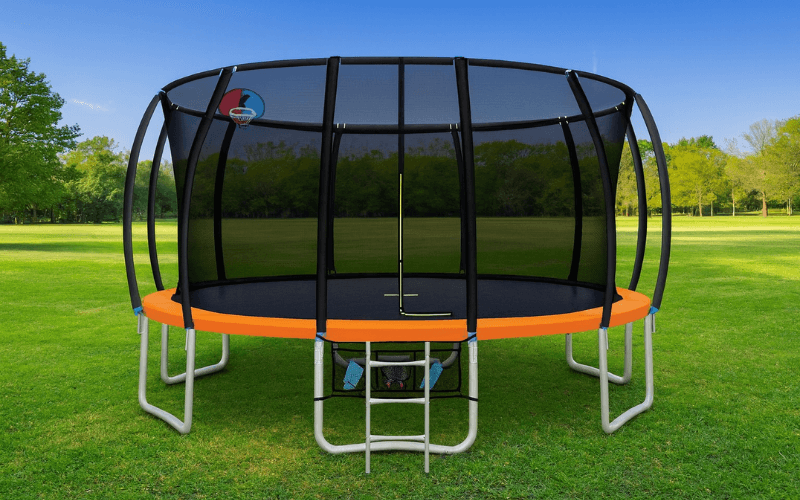
Weight capacity: 150 kg
Warranty: 3 years
The Everfit Round Trampoline is one of the cheapest full-size trampolines. At under $500 for the largest 16ft version, we recommend it for families who want a big trampoline without spending top dollar. Everfit even throws in extra accessories like a ladder, ball pump, and a basketball hoop, which you won’t usually find bundled with the premium brands.
Build quality is decent for the price. You get a heavy-gauge steel frame, UV-tested mat and padding, and 108 springs on the 16ft size. It’s also water-resistant and holds up reasonably well in outdoor conditions. That said, the materials aren’t as tough as the dual-ring steel on the Jumpflex HERO or the springless designs of Vuly and Springfree. You should also expect minimal issues with parts or fading over time, given its price range and build.
For safety, Everfit offers thick pads, an anti-graze mat, and a net enclosure with a zip-and-clip entry, backed by a 1-year parts warranty and 3-year frame warranty. The weight limit is also only 150 kg, lower than Jumpflex’s 250 kg and far below Springfree’s massive capacity.
Pros
- Affordable price
- Available in multiple sizes
- Durable and safe design
Cons
- Limited warranty
Rebounder vs. Trampoline: The Difference

Rebounders and trampolines are both used for jumping, but they differ in size, usage, and features. Rebounders are small, about 36 inches wide, and suitable for one person. They're easy to move and mainly used for low-impact exercises. They have a firm bounce for controlled moves. Some models come with a handlebar for added balance during workouts and are affordable for home fitness.
Trampolines are bigger and come in many sizes. You can use them for fitness, but they are primarily for fun, gymnastics, and team sports like trampoline basketball. The large size allows you to perform various tricks and activities. Trampolines may have safety features like nets and padding, but they're harder to move and usually cost more than rebounders.
How to Choose the Best Trampoline?
Choosing the best trampoline involves considering key factors to ensure safety, durability, and overall satisfaction. Here are some things to keep in mind when selecting a trampoline:
- Consider the available space in your yard. Our trampoline size guide is a helpful resource.
- Ensure the trampoline can accommodate your weight capacity or the combined weight of users who may be on the trampoline simultaneously.
- Choose a trampoline with a sturdy frame made from galvanised steel or other durable materials.
- Look for trampolines with safety enclosures and a safety pad covering the springs and frame to reduce the risk of injury.
- The trampoline should be built with weather-resistant materials such as rust-resistant frames and UV-resistant jumping mats.
- Consider how easy the trampoline is to assemble. Also important, check if replacement parts are readily available in case of wear and tear.
- Check the warranty provided by the manufacturer. A longer warranty period often indicates the product's quality.
Traditional trampolines use metal springs, while some newer models are springless and use alternative systems for bounce. Consider whether you prefer the classic spring design or if you want to explore springless options, which may offer a safer experience.
Local Trampoline Regulations in Australia

Trampolines should be installed, used, and maintained in accordance with the Australian Standard AS 4989:2015, Trampolines – Safety Aspects. Here are the key points:
- Condition: Make sure your trampoline is in good condition, features safety padding on the frame to avoid injuries, and a safety net to prevent you from falling off the trampoline.
- Maintenance: Regularly check that the trampoline is in good condition, making sure the mat does not have holes, the springs are intact and securely attached at both ends, the frame is not bent, and the leg braces are securely locked.
- Surrounding Area: Ensure that the area around the trampoline is free from hazards like walls, play equipment, or garden furniture and that there is a minimum overhead clearance of 8m from ground level to avoid objects like clotheslines, trees, and wires.
- Usage: Ensure only one child at a time uses the trampoline, that they jump in the center of the mat, and that they climb, not jump, off the trampoline.
Safety is paramount when using trampolines. We recommend following the manufacturer's instructions and regularly inspecting your trampoline for signs of wear and tear.
Essential Trampoline Safety Features
Trampoline injuries occur for various reasons, such as falling sideways and exposing the springs on the edges. However, thanks to new, well-designed trampolines, this is no longer a concern. Still, trampoline safety is crucial. Here are the safety features of top-quality trampolines.
#1 - Spring-free trampoline design
Spring-free trampolines eliminate injuries related to springs, like landing directly on the spring or getting pinched. Springs that are rusty or old can also pose a hazard. Additionally, spring-free trampolines provide a soft landing surface and effective shock absorption.
#2 - Non-abrasive edge mats and hidden frames
Old trampolines were designed to connect the springs to the jumping mat, then mounted on the hard metal frame to give it a bounce and hold the whole unit together. In newer designs, non-abrasive edge mats are installed around the jumping mat, and the metal frame is concealed beneath it, preventing contact and making it safer.
#3 - Protective net enclosure
Installing a net protective enclosure around the edges ensures you do not fall off a hard surface. To choose one, ensure the entry or exit point of the protective net closes up well to reduce the risk of falling off through this point—zippers or completely overlapping flaps are ideal.
The protective net's material should also be soft and not abrasive to prevent friction. Additionally, the poles holding the net along the edges must be flexible when you come into contact with them, reducing the risk of injury.
#4 - Sun protection
At the peak of summer in Australia, trampolines should have sun protection to protect jumpers from UV rays. Some trampolines come with a UV-protected roof, while others offer this feature as an additional accessory.
Health Benefits of Trampolining

Trampolining, particularly on a mini-trampoline or rebounder, offers numerous health benefits:
- Jumping builds a strong core and beyond.
- Regular trampolining can help strengthen your bones, which lessens your chances of osteoporosis.
- Rebounding improves balance, coordination, and motor skills.
- Cardio activity strengthens the heart muscles and decreases the amount of work your body has to do to pump blood.
- Trampoline exercise increases your metabolic rate, helping your body to process nutrients more efficiently.
- Trampolining increases blood flow for lower cholesterol and heart strength and decreases blood pressure, which lessens the likelihood of heart disease.
- Trampolining promotes faster reaction times, enhanced vision, and improved balance.
Essential Trampoline Accessories
Several accessories are available to enhance your trampoline experience. Examples include:
- Enclosure pole gap spacers for safety.
- Heavy-duty stainless steel springs for a good bounce.
- Screws to enhance your trampoline stability.
- Pole caps for safety and to secure the net.
- Ladder to make it easier to get on and off your trampoline.
- Storage bag to store shoes and other items while jumping.
- Sprinkler to add a fun water element to your trampoline.
- Basketball hoopto add a fun game to your trampoline.
Remember to prioritise safety when using accessories with your trampoline. Always ensure that all parts and accessories are installed correctly and check them regularly for any signs of wear and tear.
Frequently Asked Questions (FAQs)
Here are some frequently asked questions on the use and benefits of trampolines in Australia.
Can trampolines be used for exercise?
Yes, studies show that trampolines are a great way to exercise. Jumping on a trampoline helps improve fitness, bone density, and muscle strength and is just as effective as using a treadmill. It’s a good way to boost overall physical health.
What is the standard size for trampolines?
The standard trampoline size is between 10 and 12 feet. These sizes are the most popular for home backyards because they don't take up too much space. Small and medium trampolines are usually 10 feet, while medium and large trampolines are typically 12 feet.
Are trampolines dangerous?
Like many physical activities, trampolines can be risky. They can cause injuries like scratches and bumps, especially for young children. To reduce the risk, ensure your trampoline has a safety net, and avoid letting children of different sizes or ages jump together. For example, a toddler jumping with a teenager can be very dangerous.
What is the weight limit of a trampoline?
The weight limit of a trampoline is the maximum amount of weight it is designed to safely support during use. Most standard residential trampolines have a limit of 100 kg to 200 kg. However, commercial-grade trampolines support even higher weights, often over 300 kg.
Are trampolines easy to assemble?
Yes, trampolines are easy to assemble and can usually be done by two adults. The assembly process doesn’t require much in the way of special tools. Often, an Allen key and a spring loading tool are enough. Sometimes, these tools are included in your purchase with an additional assembly process or guide, depending on the manufacturer.

Wrapping Up
Today, trampolines are more than just platforms for bouncing. They have become fun exercise equipment for kids and teens, featuring various accessories to enhance the immersive experience of jumping.
Remember to add the right accessories, such as sunshades for UV protection on sunny days and ladders for easier access, to enhance your trampoline experience and provide flexibility.

